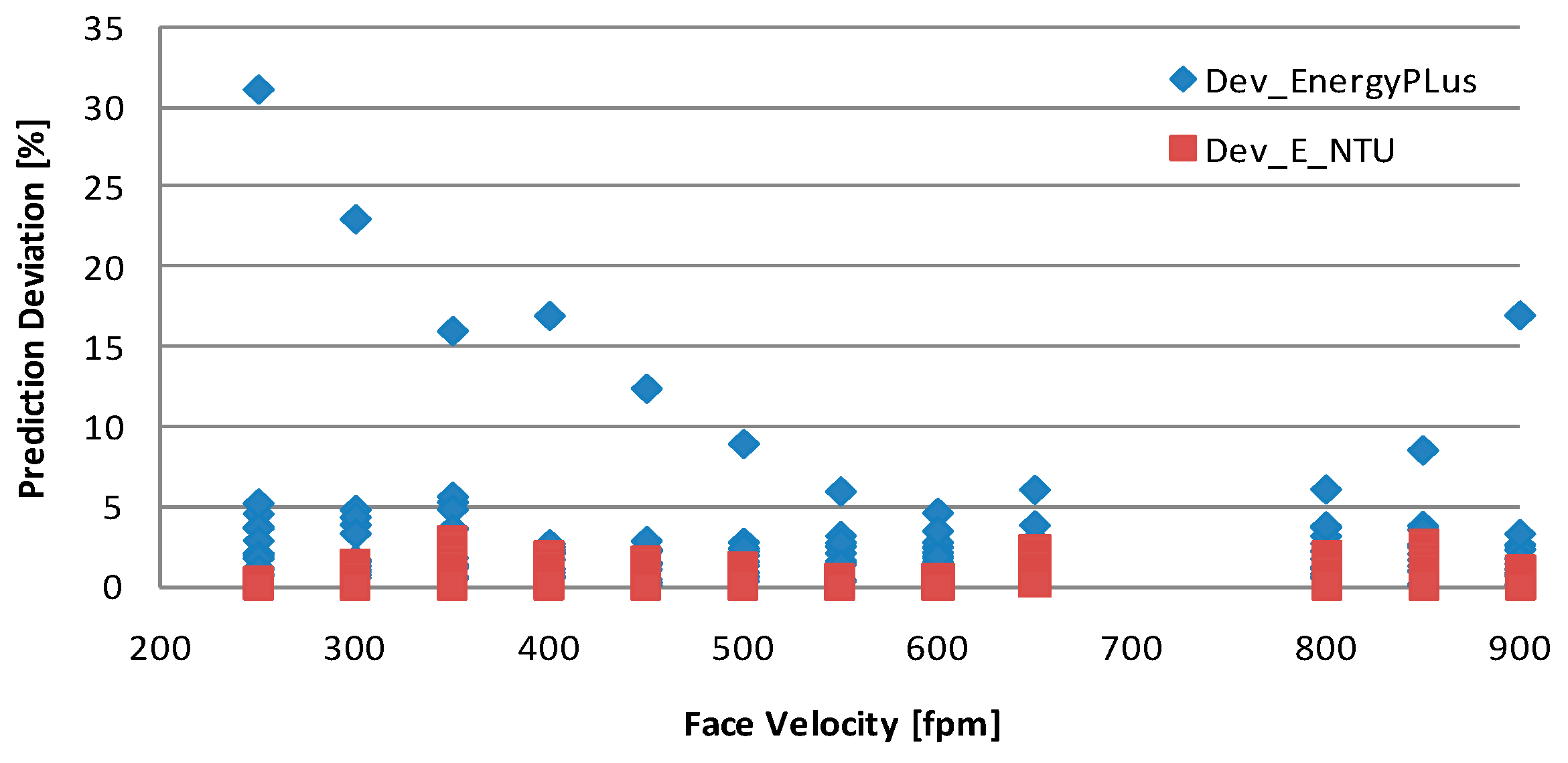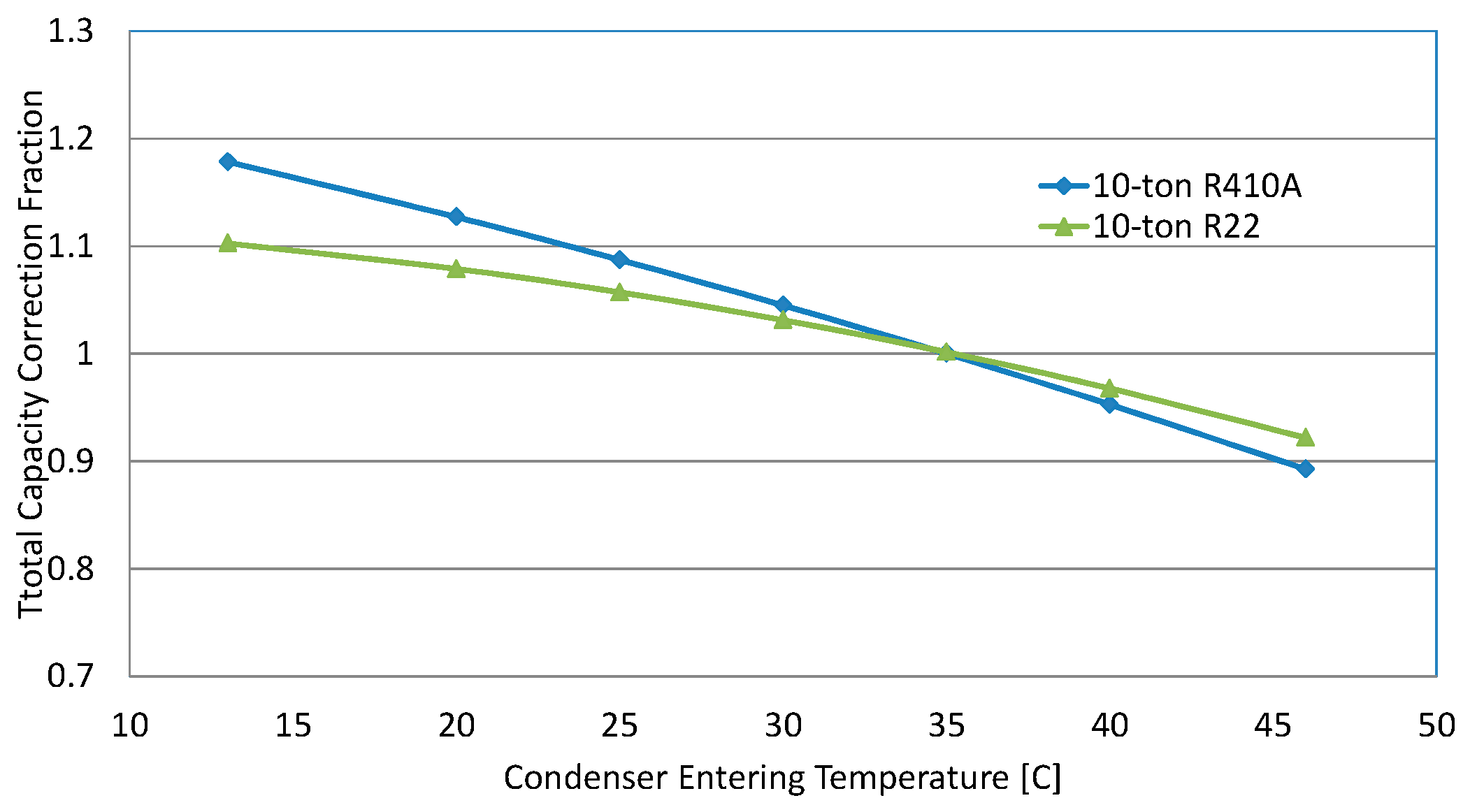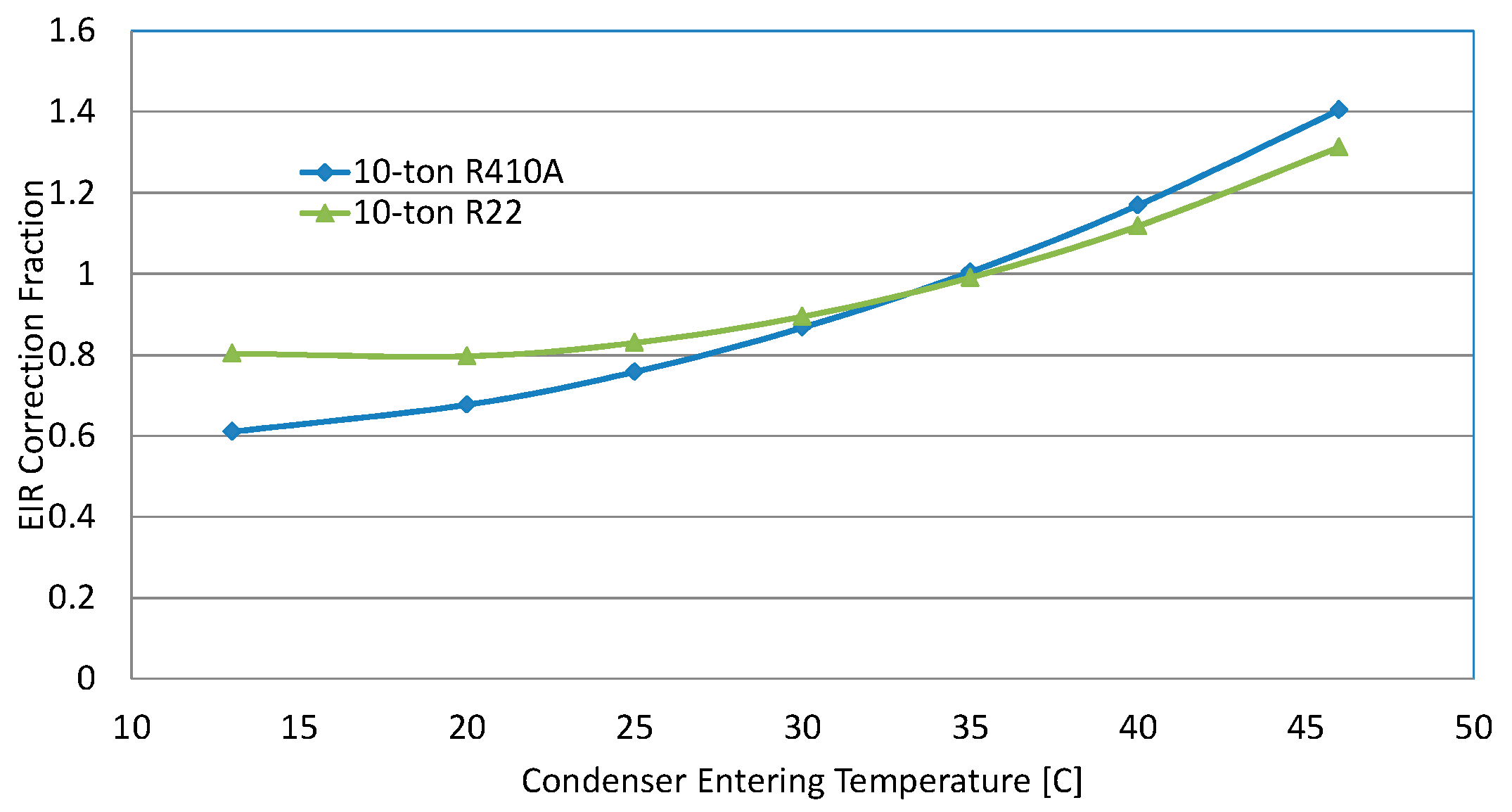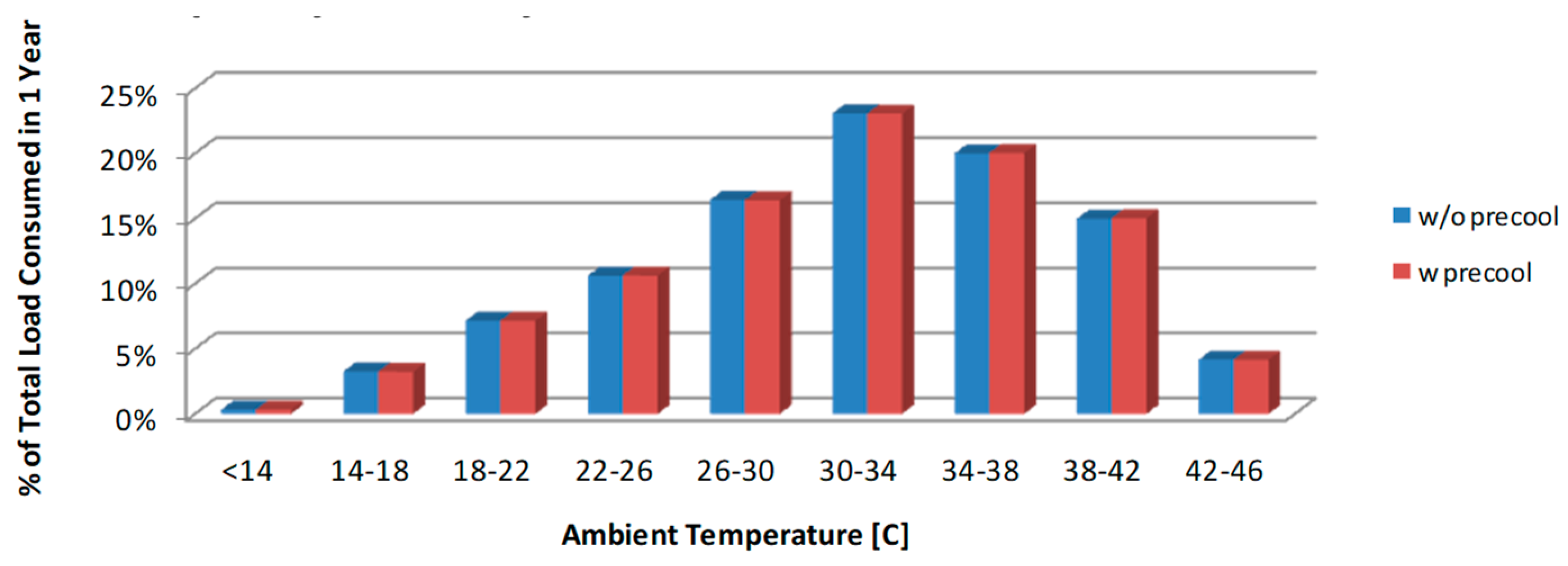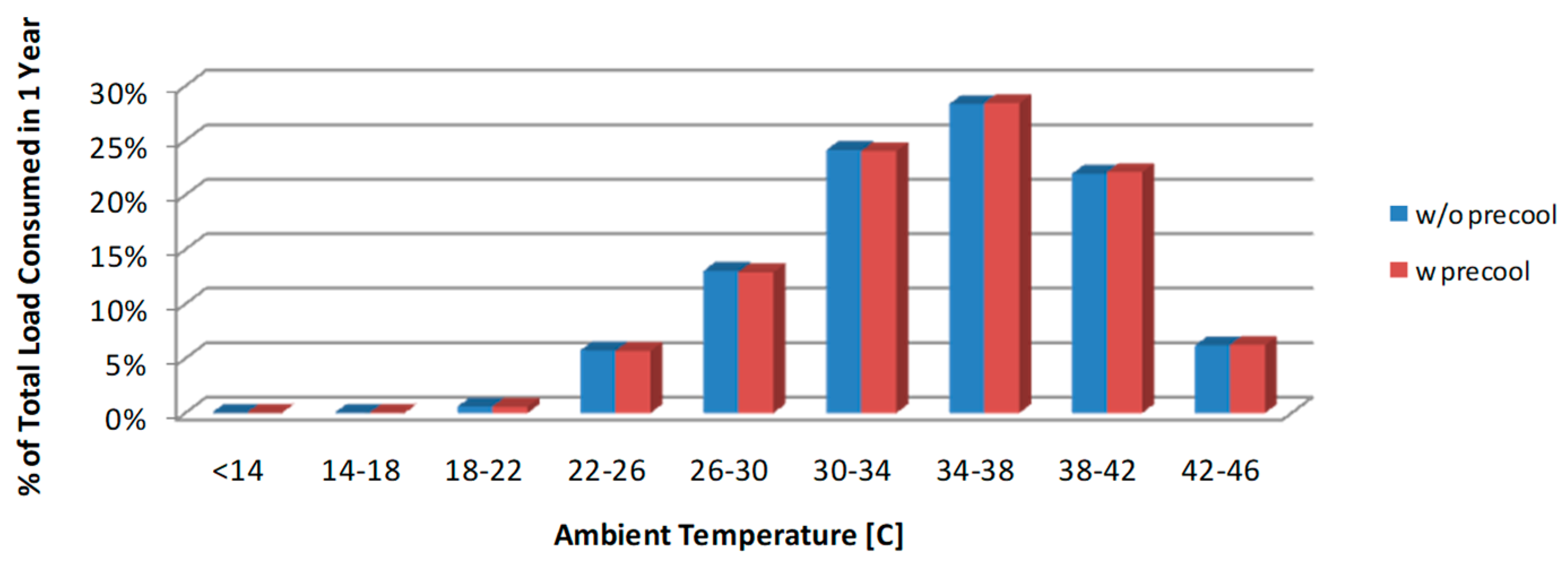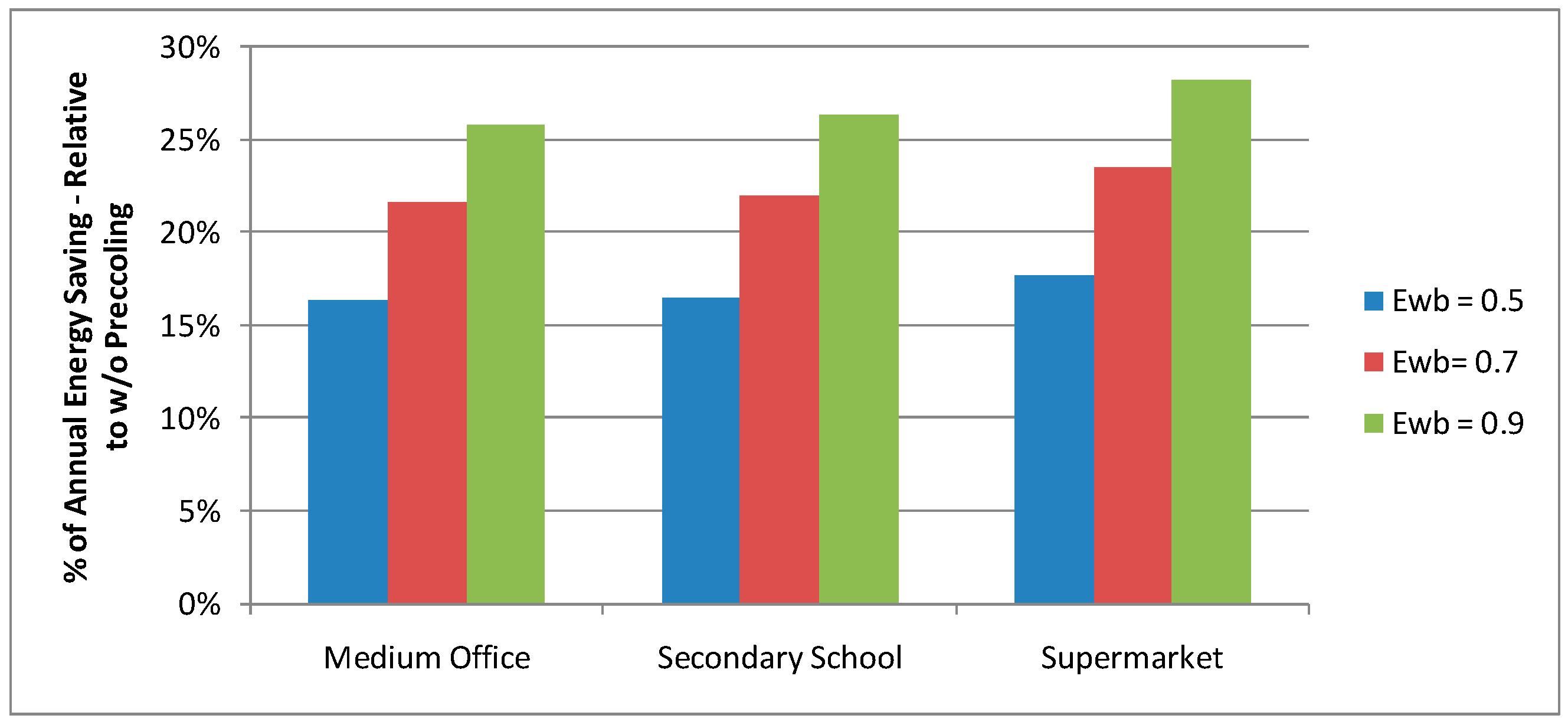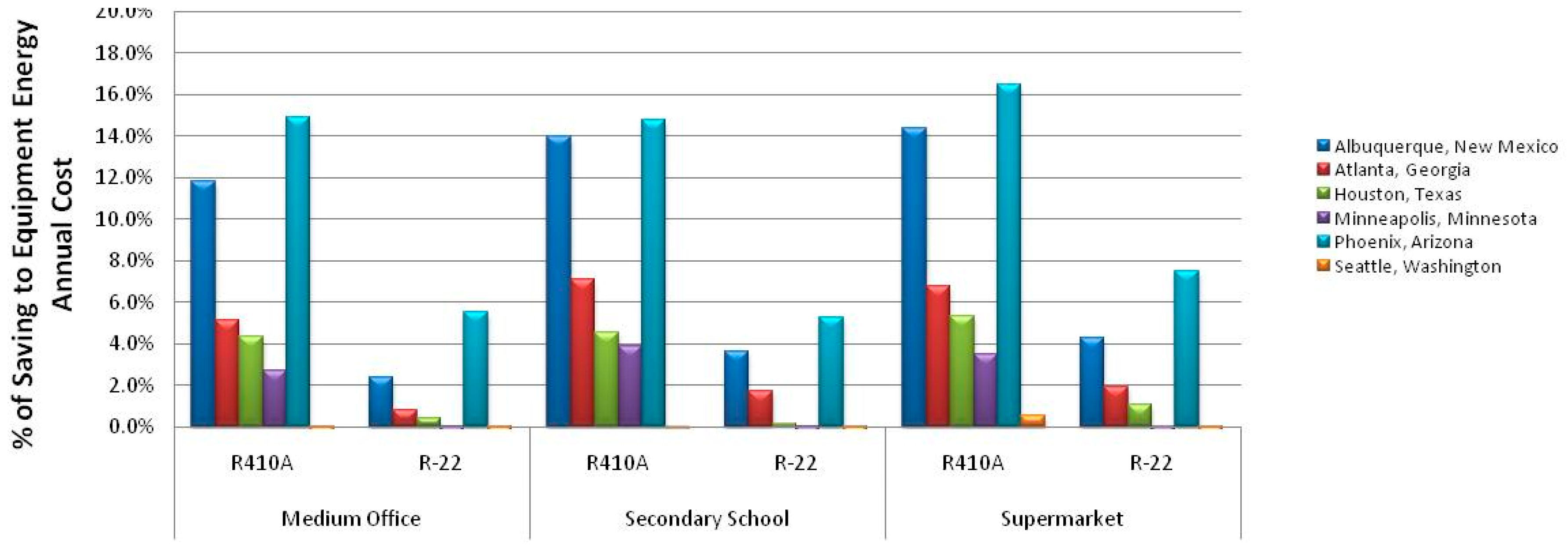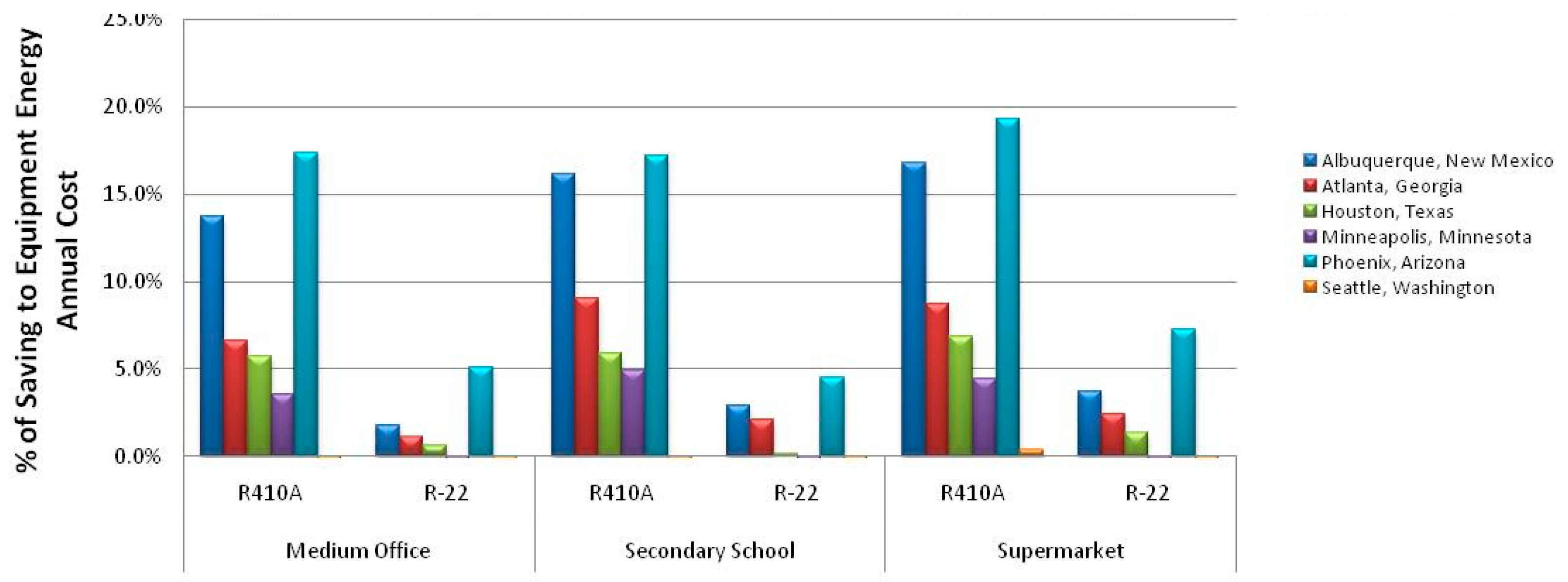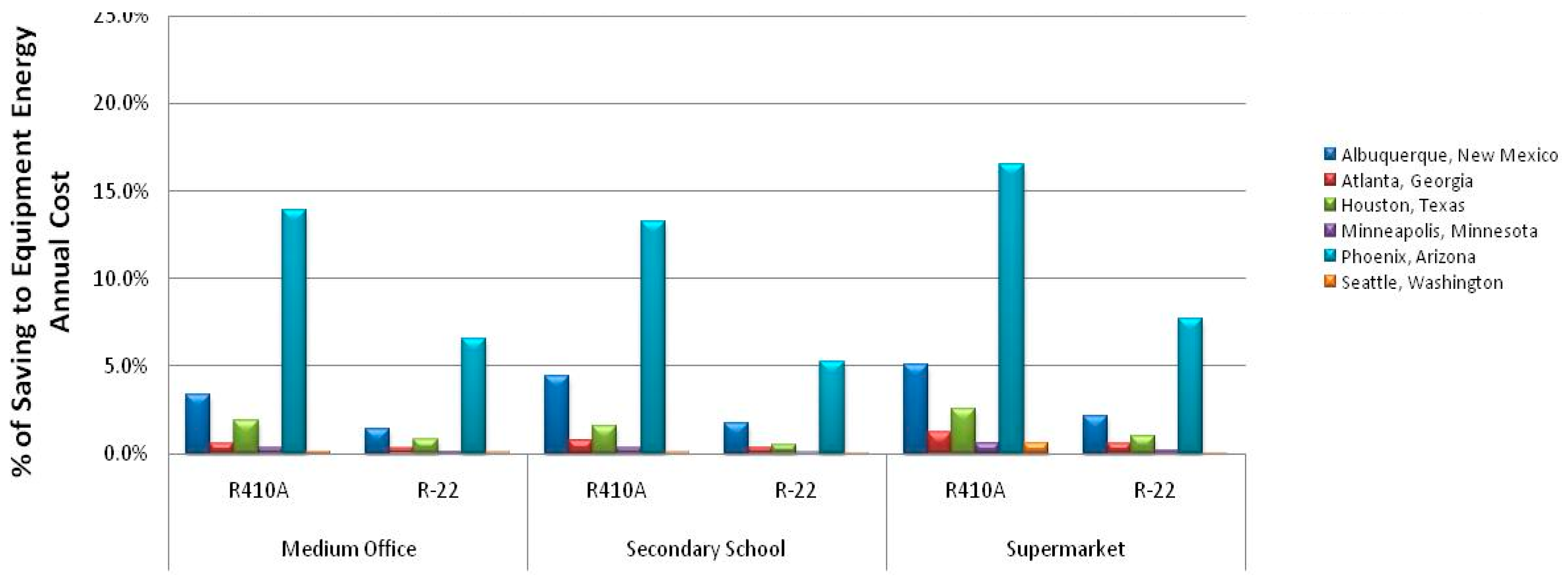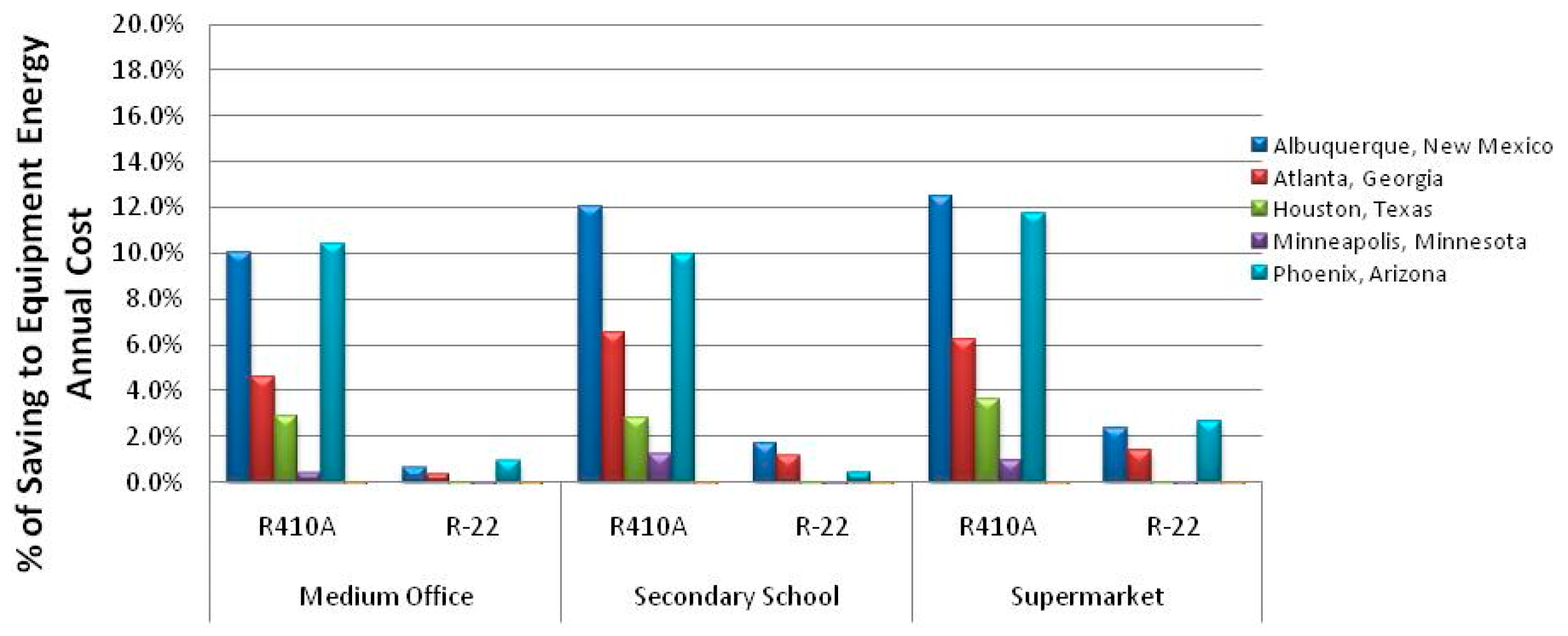1. Introduction
Evaporative cooling is a process that cools air through the simple evaporation of water. It is best suited for climates where the air is warm and dry (low humidity) because both conditions favor high rates of water evaporation that produce the desired cooling effect. Even in locations with moderate humidity, evaporative cooling may be used effectively, especially in the commercial and industrial sectors. In direct evaporative cooling, water is sprayed on a substrate that is placed in the air stream to be cooled. This technique may be used to cool indoor as well as outdoor air. When applied to outdoor air, the wetted media cools down the air entering the condenser coil and the process is called evaporative pre-cooling. Pre-coolers achieve energy savings because the entering air temperature to the condenser coil is lower, decreasing the lift imposed on the vapor compression cycle. These systems have the potential to be deployed immediately at scale for annual power savings and peak power demand reduction in many parts of the country at an attractive payback.
There have been many literatures addressing the evaporative pre-cooling effect around the world. Wu et al., [
1] developed a simplified model to describe heat and mass transfer process in evaporative coolers, and validated the model against a wide range of air temperatures, humidities, velocities, and pad thicknesses, etc. They conducted numerical and analytical modeling practices for evaporative pre-cooling, and applied the model in four different regions in northwest China. Wu et al., [
2] applied the same model to optimize the frontal air velocity for a given pad geometry. They demonstrated that the pre-cooling effects were significant for the desert climates in China. Waly et al., [
3] evaluated the condenser evaporative pre-cooling option on a 2.8-ton/9.8 kW R-22 split unit in Kuwait, and they identified power savings ranging from 8.1 to 20.5%, as a result of the increase in coefficient of performance (COP) ranging from 36 to 59%. Hajidavalloo [
4] investigated a window- size R-22 air conditioner with condenser pre-cooling in Iran. The experimental results demonstrated that the pre-cooling reduced the power consumption by 16% and increased COP by 55%. The author recommended using the pre-cooling technique in very hot climate zones, where the pay-back period for adding the condenser pre-cooling devices can be less than one year.
Goswani et al., [
5] performed an experimental investigation of performance of a residential air conditioning system with an evaporatively-cooled condenser, based on a 2.5-ton/8.8 kW residential air conditioning system. For the residential application, they investigated seven U.S. locations (Miami, Orlando, Jacksonsville, Key West, Panama City, Fort Meyers and Tampa). It should be noted that the seven locations include a very humid climate zone like Panama City, where the evaporative pre-cooling saving is less significant. At the end, they concluded the payback periods to cover the retrofit cost (pad, pipe, pump, etc.) are less than 2 years. Yu et al., [
6] used mist precooling to enhance efficiency of an air-cooled chiller. They concluded that the mist precooling could increase the coefficient of performance up to 10.2%. Liu et al., [
7] applied an evaporative-condenser in a gas-engine drive heat pump system, and their experimental results showed that the efficiency increase due to the evaporative condenser was 28.1%, as compared to an air-cooled condenser. Xuan et al., [
8] conducted a comprehensive review of evaporative cooling technologies as applied in China. Kim et al., [
9] used direct and in-direct evaporative cooling in a 100% outdoor air system. They observed more significant energy savings in the intermediate season than the cooling season. Eidan et al., [
10] studied the effects of condenser evaporative pre-cooling on a small window air conditioner in Iraq’s climate where the air temperature can reach 55 °C. They reported that the precooling was able to extend the working range to the extreme temperature, and reduce peak power consumption. The evaporative pre-cooling enabled the compressor to work at 16% lower voltage than 220 V.
The above literatures indicate significant saving potentials and short pay-back periods worldwide using condenser evaporative pre-cooling techniques, but these investigations have been limited in equipment, building types, climate zones, etc. Especially, we didn’t find much investigation related to U.S. commercial applications. In order to promote the quick and wide application of the pre-cooling technique in the U.S. market, we need to extensively assess this promising technique covering all the variances of equipment, buildings and climates, etc. This work intends to provide a comprehensive reference evaluation, in terms of annual energy savings, peak power reduction, water consumption, payback period, for applying the condenser evaporative pre-cooling technique nationwide.
We introduced a mathematical model to correlate the wet bulb efficiency of an evaporative-precooling pad, which requires less data points for fitting and has better accuracy than the current model used in EnergyPlus [
11]. The model comparison was based on a manufacturer’s data in a wide range of pad thicknesses and frontal air velocities. Next, EnergyPlus was used to conduct parametric simulation studies covering sixteen US cities, three commercial buildings, three generations (present, before 1980 and post-1980) of rooftop air conditioners using two refrigerants (R-22 and R-410A), respectively. Energy and economics saving potentials were revealed with respect to the multiple influential factors.
2. Mathematical Models
To model the evaporative cooling heat and mass transfer process, the basic assumptions generally include the following: the pad is fully wet, and is exposed to entering air of uniform temperature, humidity and velocity. The boundary layer between the entering air and the wet pad is saturated air at the pad surface temperature. The pad surface has a uniform bulk temperature, i.e., no heat and mass transfer occur within the pad structure. The pad’s thermal capacity and transient temperature change are ignored. There is no heat transfer from the surroundings, other than the entering air.
EnergyPlus [
11] is capable of simulating direct evaporative cooling for both indoor as well as outdoor components. Described by EnergyPlus [
11], the parameter for gauging efficiency of the evaporative pre-cooling process is the wet bulb (WB) efficiency, which is a measure of the drop in the dry bulb temperature due to the evaporative process. The wet bulb efficiency,
Ewb, is defined in Equation (1) as:
where
is the wet bulb efficiency;
and
are the entering and leaving air dry bulb temperatures, respectively; and
is the entering air wet bulb temperature. The maximum possible wet bulb efficiency can be unity when the leaving air dry bulb temperature is cooled to the entering wet bulb temperature. If the wet bulb efficiency is zero, the pad, substrate, or media is dry and evaporative cooling effect is absent.
In EnergyPlus [
11], evaporative cooling is treated as a heat transfer process between air and water, following a constant wet bulb temperature line in the psychrometric chart. The media geometry (thickness) and the face velocity (the velocity of air entering the outer surface of the media) are major independent variables that impact the wet bulb efficiency. Other factors like supply water temperature, flow rate, and external heat to the water stream have relatively minor impact. For direct evaporative cooling, EnergyPlus simulates the WB efficiency using a curve-fit polynomial equation with media thickness (Depth) and face velocity (Velocity) as the independent variables, as depicted in Equation (2):
The EnergyPlus curve-fit form of calculating evaporative cooling efficiency requires a large body of empirical data to obtain the 11 parameters required in the equation and, being a curve fit, is also not physically meaningful.
Braun et al., [
12] presented an innovative effectiveness-NTU approach to model a wide range of cooling towers and cooling coils. Through detailed analytical work, Braun et al., [
12] treated the simultaneous heat and mass transfer process between sprayed water and entering air as an enthalpy-potential-driven process, characterized by a Lewis Number of unity. Since the Lewis Number is defined as the ratio of thermal diffusivity to mass diffusivity, a value of unity means that the thermal and mass exchanges are of equal significance. Braun et al., [
12] proposed three new operational concepts in their model of simultaneous heat and mass transfer process: (1) that the heat and mass transfer rates are proportional to the difference of the enthalpy of saturated air at the entering water temperature and the enthalpy of entering air; (2) introduced a new parameter
called the specific heat of saturated air, which can be obtained as in Equation (4); (3) defined the ratio of saturated air specific heat flow rate to the water specific heat flow rate,
as in Equation (5):
where:
= total energy transfer rate,
= enthalpy of saturated air at the entering water temperature,
= enthalpy of entering air,
= heat and mass transfer effectiveness, defined later in Equation (7).
With these three operational concepts, Braun et al., [
12] defined the number of transfer units (NTU) and the effectiveness
for evaporative cooling by a simple mathematical form. The NTU and
both maintain the same form as that for sensible heat transfer applicable to a wide range of counter, parallel and cross-flow geometries. Assuming constant water temperature on the surface of the wet media, we can get
in the form of Equation (7). Thus:
where:
= heat transfer coefficient between air and water stream,
= heat transfer surface area, usually taken as the pad area,
= mass flow rate of dry air,
= specific heat of dry air at dry bulb conditions,
= water surface temperature (constant).
It should be noted that Braun et al., [
12] defined the wet bulb efficiency,
(Equation (7)) more generally than is described by
in Equation (1). In the case of direct evaporative cooling, if the amount of water that is sprayed is much less than the amount of water resident on the pad, i.e., sensible water heat transfer is negligible, then
and
becomes identical to
. In practice, we want the amount of water sprayed on the pad to be small and, in fact, commercial equipment makers control water supply very diligently to apply a fine mist, just enough to wet the pad surface area.
Under these conditions, Wu et al., [
1] combined Equation (1) and Equation (7), taking
to yield:
Further, Wu et al. [
2] formulated the following equations for the air heat transfer coefficient,
, the surface area for evaporative cooling,
, and the air mass flow rate:
where
a, c, and m in Equations (9) and (10) are constants specific to the pad geometry,
δ is the pad thickness, and
is the density of ambient air [kg/m
3].
is the frontal air velocity [m/s]. Substituting
from Equation (11) in Equation (6) gives the final form for the NTU:
where
α and
n are empirical constants specific to the pad.
An overall mass balance on water gives the water mass flow rate in terms of the humidity ratios of the entering and leaving air,
and
[kg water/kg dry air], respectively, given by:
Based on the approaches of Braun et al., [
12] and Wu et al., [
1] our proposed coupled heat and mass transfer model utilizes Equations (3), (7) and Equations (8)–(13) to solve for
and
iteratively.
All the equations above from the references are used for the model validation in the section below. Our approach to model validation is based on a comprehensive set of manufacturer’s performance data for a specific type of evaporative pad. The data set consists of 13 levels of pad thicknesses ranging from 1 in to 24 in (0.025 m to 0.61 m), frontal air velocities from 250 fpm to 900 fpm (1.3 to 4.6 m/s) (12 levels) and wet bulb efficiencies ranging from 17.5% to 99.6%. The 12×13 matrix of data points were used to fit the coefficients from through for the polynomial curve fit used by EnergyPlus as depicted by Equation (2), and to obtain the parameters α and n used in Equation (12) by Braun’s model.
Our criteria for deciding goodness of a model is to demonstrate how closely the model predicts the measured data gathered by the manufacturer. A good model will show small deviations from actual field measurements.
Figure 1 compares the predicted deviations of the EnergyPlus polynomial curve-fit calculations of the wet bulb efficiency and the effectiveness-NTU model versus manufacturer’s data. The effectiveness-NTU method is significantly more accurate with prediction errors having a standard deviation of 0.67% with maximum deviation of 2.9%. In contrast, EnergyPlus with the polynomial curve-fitted equation has a standard deviation of 4% with a maximum deviation of 31%. Prediction deviations are defined as (Model Prediction—Manufacturer’s data)/Manufacturer’s data. We compared the predictions over a wide range of face velocities. With EnergyPlus, big outliers are observed at the upper and lower bounds of the face velocity, whereas for the effectiveness-NTU approach, the predictions are closer and uniformly distributed across a wide range of face velocities even at the upper and lower bounds of face velocity. These simulations are shown in
Figure 1.
On the basis of these comparisons, we conclude that the effectiveness-NTU model is easier to use, and yet gives much better agreement with manufacturer’s data than the approach used in EnergyPlus for evaporative cooling. The current EnergyPlus requires constant wet bulb efficiency for modeling condenser evaporative pre-cooling at each equipment speed. So the effectiveness-NTU model can be an efficient tool to predict the wet bulb efficiency as an input to EnergyPlus, based on the actual pad geometry and condenser frontal air velocity.
We used EnergyPlus to conduct parametric building energy simulations. In EnergyPlus, direct-expansion (DX) air conditioners, i.e., rooftop air conditioners, are modeled in the form of performance curves. The equation forms are given as below:
where
= Coil Cooling Capacity Correction Factor (function of temperature);
= unit total (sensible + latent) cooling capacity [W];
= rated total (sensible + latent) cooling capacity [W];
= wet-bulb temperature of the air entering the cooling coil (°C);
To = temperature of the air entering an outdoor heat exchanger (°C); and
= bi-quadratic equation coefficients for Cooling Capacity Correction Factor.
The DX cooling coil energy input ratio (
EIRFT) also depends on the wet-bulb temperature of the air entering the cooling coil and ambient temperature.
= the cooling energy input ratio correction factor (function of temperature). is the unit rated COP. The rated conditions for obtaining the capacities, COPs and SHRs are at an indoor dry-bulb temperature of 26.67 °C (80 °F), wet bulb temperature of 19.44 °C (67 °F), and condenser entering air temperature of 35 °C (95 °F).
For simulating a unit with an evaporatively cooled condenser, EnergyPlus simply corrects the condenser entering air temperature
in the form as Equation (18):
where
and
are the ambient dry bulb and wet bulb temperatures, respectively. Since the condenser air velocity and the evaporative pad thickness are usually fixed for an existing rooftop unit, the
can be inputted as a constant value for a building simulation case at one fixed condenser air flow rate.
EnergyPlus auto-sizes rooftop equipment to match building sensible loads under design days—the statistically hottest day in summer. Operating conditions in design days would vary regarding to locations. Working as a safety factor, the equipment sizing factor is set to scale the equipment rated capacity. If the sizing factor is larger than unity, it means the equipment is oversized in comparison to the required building sensible load. Consequently, the building comfort level is increased, but at the expense of the cyclic loss. However, the equipment sizing factor might vary according to building type, since an individual building type might have a specific comfort level regulation.
EnergyPlus is capable of simulating single-speed, two-speed and multiple-speed rooftop equipment. For two-speed equipment, EnergyPlus uses the rated capacity at high speed to match the building peak sensible load in design days, and the rated capacity at low speed would be assumed as 1/3 of the rated value at the high speed. In addition, for two-speed equipment, we can input evaporative pre-cooling wet bulb efficiency specific to each speed and condenser air flow level.
Certainly, for modeling condenser evaporative pre-cooling, we need to consider the expense in exchange of the energy saving, which are water evaporation and pump power consumed. In EnergyPlus, the evaporative condenser pump rated power consumption is modeled as the total cooling capacity times 0.004266 Watts pump power per Watt rated capacity, i.e., 15 W/ton. For two-speed rooftop equipment, at low speed, the pump power is set equal to 1/3 times the total cooling capacity times 0.004266 Watts pump power per Watt capacity. It should be mentioned that we ignored the extra condenser fan power due to adding the precooling pad upstream of the condenser, since the condenser fan power consumption is less than 10% of the total equipment power consumption, and the extra fan power caused by the precooling pad is marginal, i.e., 2 to 3% to the total power.
The water consumption rate is calculated by the difference between the entering and exit air specific humidity multiplied by the condenser air mass flow rate. A standard rated condenser air flow rate is between 0.00004027 m3/s and 0.00006041 m3/s per Watt of rated total cooling capacity, i.e., 300–450 cfm/ton. The water evaporation amount would be integrated along the running time fraction during operation.
